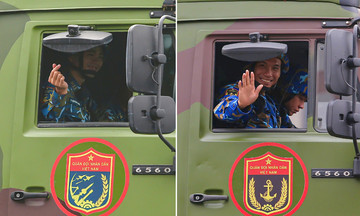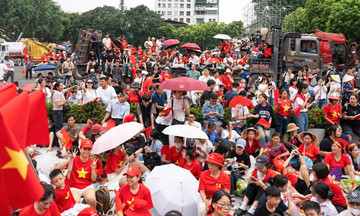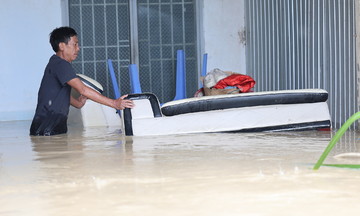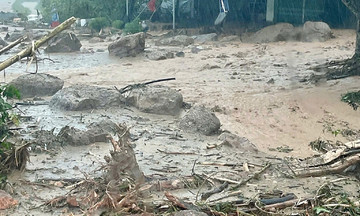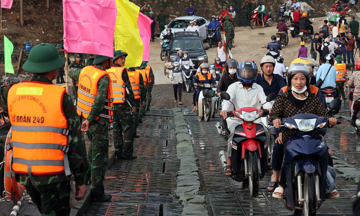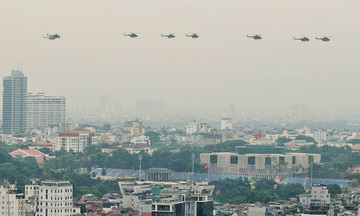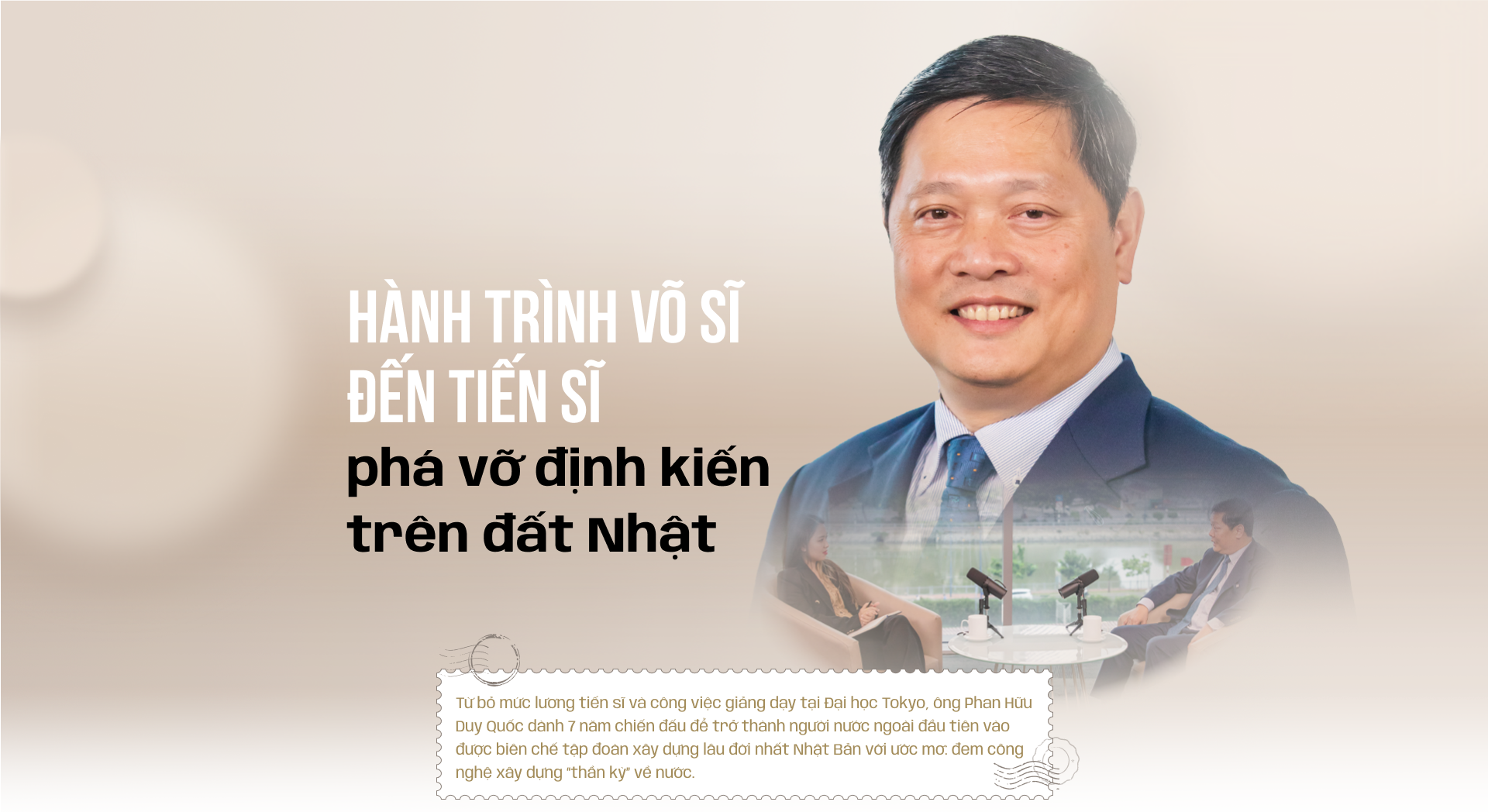 |
Phan Huu Duy Quoc during his time in the construction research group at the University of Tokyo. Photo provided by the subject. |
While working on Ho Chi Minh City's first metro line, Quoc recognized systemic bottlenecks. He decided to return to Vietnam to directly contribute and address these obstacles as a member of the State Acceptance Council's expert panel.
In an interview with VnExpress, Dr. Phan Huu Duy Quoc discusses his martial arts spirit, the years he spent quietly breaking down stereotypes in Japan, and his choice to return to Vietnam to help resolve bottlenecks in key national projects.
A former martial artist on the Vietnamese Taekwondo team, a national champion in Japan in 2002, and the winner of the selection tournament to represent Japan in the world championship - what led you to your current role as a construction doctor and expert in transport infrastructure?
I was born in a bomb shelter in Hue during the war. My parents named me "Huu Duy Quoc," meaning "to have one united country." This name has instilled in me a special sentiment, a sentiment that becomes even clearer when I face big decisions.
My childhood was always divided between two pursuits: studying to advance myself and practicing martial arts out of passion.
In 1996, I faced the first major choice between these two paths. At the time, I was a lecturer at Bach Khoa University. In martial arts, due to prior achievements, I was selected for the national team to prepare for the 19th SEA Games. From early 1997, I dedicated myself to training. Suddenly, in October, I received a full scholarship for a master's degree in construction from the University of Tokyo, a top university in Japan.
That was a time of intense conflict for me. I still remember the words of coach Le Trung Liem, former head coach of the Vietnamese national team who led me to a national silver medal and a Ho Chi Minh City gold medal, before he passed away: "Sports in Vietnam at this time cannot be a long-term career." I decided to put aside my dream of wearing the national team uniform and chose to study abroad.
During my first months in Japan, on the train to school each day, I often cried. I kept imagining myself standing on the podium, wearing a gold medal, listening to the Vietnamese national anthem. It was something I had longed for since childhood, especially during my student days when I had to watch the Vietnamese team play through the ventilation holes of the Phan Dinh Phung stadium because I couldn't afford a ticket.
After a period of studying for my master's, I returned to Taekwondo as a way to hold onto my passion. In every training session, I wore a dobok with the Vietnamese flag. In 2002, I won the middleweight division of the Japan National Championship. In 2003, I won the selection tournament to represent Japan in the World Championship. I was invited to become a Japanese citizen to compete. But since Japan doesn't allow dual citizenship, I had to decline. Giving up my Vietnamese citizenship was unthinkable.
That was also the decision that ended my professional martial arts journey a year later. But by then, my achievements in a "foreign land" had somewhat eased the pain of my unfinished dream with the Vietnamese national team. I had just defended my doctoral dissertation. And for the first time, without the burden of intense training, I clearly saw the path ahead: to continue learning and accumulating experience in the construction industry to prepare for my return.
 |
After setting aside your passion for martial arts and completing your doctoral studies in construction in Japan, what did you envision as your next step?
After defending my dissertation, I was invited to research and teach at the University of Tokyo. It was a safe and prestigious option. But during that time, I served as the President of the Vietnamese Youth Association in Japan, frequently working as an interpreter and supporting delegations from Vietnam. This gave me the opportunity to listen, observe, and realize that Vietnam lacked people with practical construction experience and engineers with experience in large-scale projects.
I began to worry. The program at the University of Tokyo focused on specialized theory, very academic. If I only stayed in the lecture hall, I wouldn't be able to contribute to the implementation of large infrastructure projects upon my return.
Meanwhile, I had witnessed and participated in seemingly impossible feats that the Japanese performed routinely, such as constructing a new metro line beneath an operating airport terminal and digging a tunnel through the seabed from two sides, meeting precisely in the middle.
The most striking observation for me at that time was Japan's superior public transportation system. Throughout my years in Japan, I never owned a motorbike or car. All my travel needs were met by the metro and trains. I dreamed that one day, Vietnam would also have such a modern metro system. From these encounters and observations, I clearly saw that the country was yearning for change and needed experts to bridge the decades-long gap with developed countries.
I realized that if I remained confined to the lecture hall, I couldn't make a practical contribution to project implementation upon my return. With sufficient methodology and specialized knowledge, I decided to stop researching and teaching at the University of Tokyo and sought practical work opportunities. I applied to Shimizu, one of the oldest construction companies in Japan.
You were the first person to make Shimizu break its 210-year tradition of not hiring foreign personnel. How did you achieve that?
This turning point came with many challenges; I officially entered a battle. Initially, my doctorate didn't give me much of an advantage at Shimizu in terms of practical experience. My salary was the same as a recent graduate. My income was halved compared to when I was a lecturer. During 2005–2006, almost no Japanese construction company accepted foreigners as official employees.
It took me 7 years to become a permanent employee, to prove that someone with a doctorate also has advantages if they know how to apply methodology, research skills, problem-solving, and innovation.
I proactively explored and learned more than what was assigned, both to demonstrate my abilities and to expand my practical knowledge. I observed, proposed solutions, and developed construction technologies. Many of my inventions are still used in Shimizu's general procedures.
One of my first inventions was a device to check concrete quality using microwaves. In construction, ready-mixed concrete from factories is commonly used, but sometimes the water content is higher than the design specifications. Excessive water affects strength and durability. The problem is that when the concrete arrives at the construction site, nobody knows how much water it contains. I thought of the principle of a microwave oven: more rice requires longer heating because the water molecules in the food absorb and dissipate the waves. From there, I invented a device that emits waves to measure the water content in fresh concrete. This invention was incorporated into Shimizu's quality management system, used for bidding and construction control to this day.
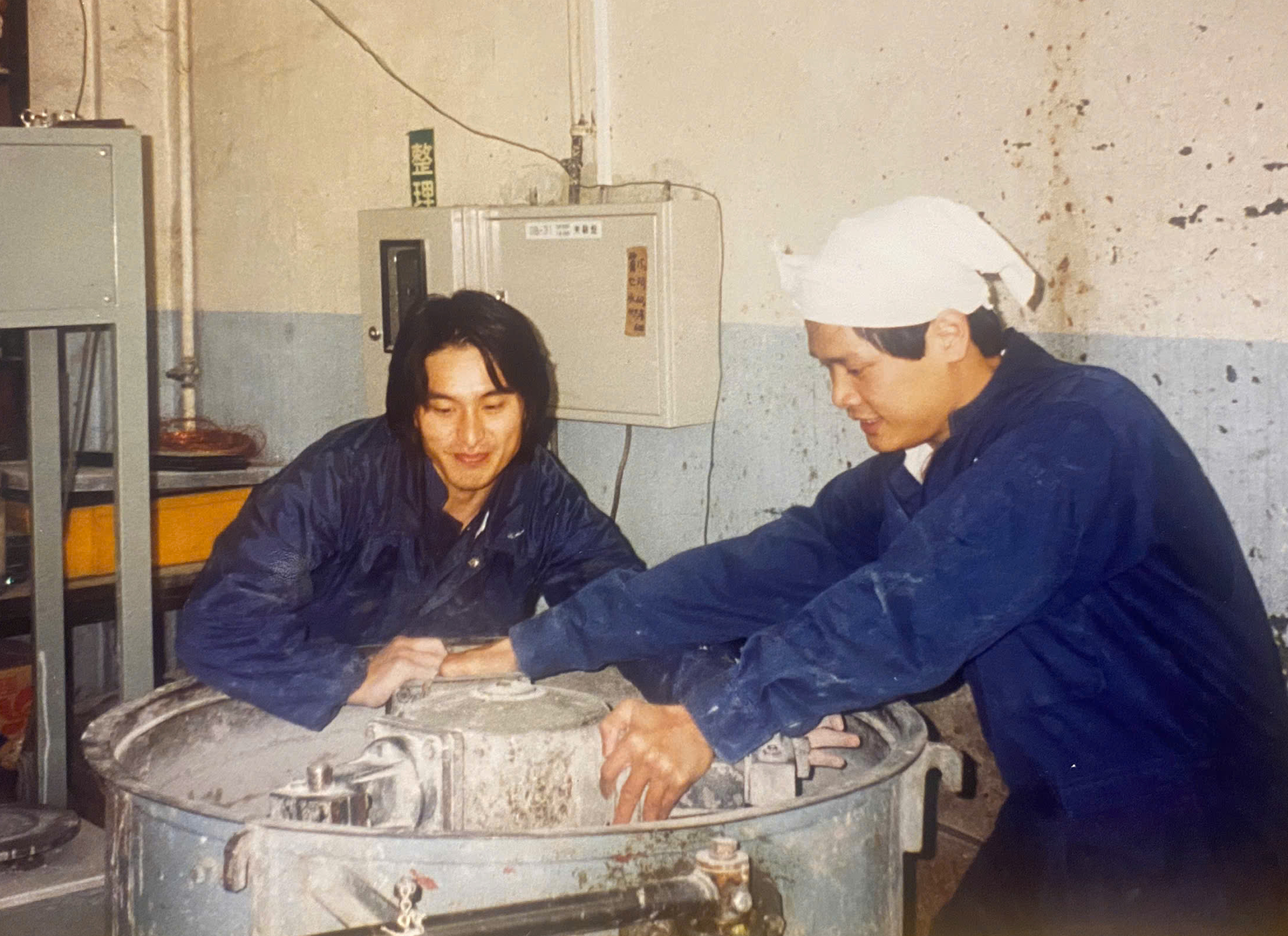 |
Phan Huu Duy Quoc during his time in the construction research group at the University of Tokyo. Photo provided by the subject.
Thanks to these contributions, I was granted permanent employment and promoted to a management position. But even then, the prejudice hadn't completely disappeared.
Once, as a representative of the technical department, I inspected the construction quality at a site and discovered a problem. However, the chief engineer dismissed me, saying, "I don't need you." I calmly explained and did my job. The next day, when the formwork was removed, the structure was flawed, just as I had warned. That engineer faced internal disciplinary action.
I realized that if I did my job correctly, thoroughly, and took responsibility, it would change their perspective. For me, that journey was a silent battle, using results to speak for themselves. After me, many other foreigners joined Shimizu and were hired permanently from the start.
I always approach everything with the spirit of a martial artist.
Martial arts are often associated with the word "dao" (way): Judo, Jeet Kune Do, Taekwondo, Karate-do – the path of discipline, perseverance, and willpower. Japanese martial artists have the term "samurai spirit" - never give up, fight as if it's the last battle of your life, fight until you collapse.
I also realized that martial arts is not just about learning to defeat an opponent but learning to conquer oneself. Once, my teacher made me hold a horse stance for 60 minutes. At first, my body wanted to give up. But overcoming it, I suddenly understood that if I could control my body, I could also control my thoughts, reactions, and patience.
I used to tie my hands in front of my chest and practice kicking a tree thousands of times to separate the movement of my upper body from my legs and eyes – a way to neutralize an opponent's judgment. I trained my mind by walking barefoot on sharp gravel without flinching or walking alone through a graveyard at night. These exercises helped me hide my emotions, endure pain without showing it, and especially, not give up.
I carry this "samurai spirit" into every aspect of my life, from training and research to work.
After nearly 20 years of living and working in Japan, what made you determined to keep your Vietnamese citizenship?
The decision not to become a Japanese citizen did put me at a disadvantage. As a foreigner, I could only sign annual labor contracts, facing the risk of termination if I didn't meet requirements, leading to visa non-renewal. This created instability and limited my work duration. If I had Japanese citizenship, I could do any job without visa restrictions.
However, that wasn't an issue for me. Having lived, paid taxes, and worked in Japan for decades, obtaining citizenship was entirely feasible. If I wanted, I could simply apply and almost certainly be approved, but I never considered it.
I dreamed of returning and contributing what I had learned. Contributing with my Vietnamese citizenship would make me prouder.
Besides deepening your knowledge and experience in the construction industry in Japan, what else did you prepare for your return?
My two greatest assets upon returning were practical knowledge and relationships, both with Vietnamese and Japanese people.
Nearly 10 years after leaving the University of Tokyo, I immersed myself in the Japanese construction market, learning how things worked in practice.
At the same time, I actively built my network. From my time as President of the Vietnamese Youth and Student Association in Japan to my roles as Vice President of the Vietnamese Association in Japan, Head of the Vietnam-Japan Relations group in Japanese construction engineering associations, research councils, and so on, I had the opportunity to meet and connect with many people. Many classmates are now university presidents, institute directors, and leaders in state agencies. Many Japanese friends who were former colleagues are still willing to help when I need documents or support.
Networks don't appear spontaneously, and they certainly can't be built in a few years. Therefore, I believe the longer one stays, the more value one accumulates before returning. I chose to return, but I don't think Vietnamese people who haven't returned aren't contributing. The world is flat now. There are expert council meetings for the city where people from Germany, France, and Singapore regularly participate – they are all Vietnamese experts living abroad. They are still contributing, just in different ways.
I returned because I felt I had enough: both practical experience and a strong enough network to start doing something for the country. But I believe that wherever one is, the most important thing is to maintain a connection with the homeland – not necessarily measured by geographical distance.
 |
What led you back to Vietnam after 20 years of studying and working in Japan?
In 2014, when Ho Chi Minh City began implementing Metro Line 1, Shimizu Corporation participated in the bidding for package CP1b, constructing the underground section from Ben Thanh Station to Suoi Tien Station. I proactively proposed to the company that I be allowed to participate in the project. They readily agreed because they had long known about my extensive network of contacts from previous interactions, my fluency in English, Japanese, and Vietnamese, and my practical experience with urban underground projects in Japan.
From 2014, I directly participated in the initial phase of Metro Line 1 construction, traveling between Japan and Vietnam for three years on long-term assignments. This was the most meaningful period for me because I was involved in laying the first bricks for the city's Metro Line 1. However, it was also here that I witnessed many difficulties.
The first 20 km of the Ben Thanh - Suoi Tien metro line took 17 years to complete. The project was delayed by a "maze of regulations," administrative and legal obstacles. There were times when the city couldn't disburse funds, leaving the contractor owed thousands of billions of VND.
I realized that if I remained in the contractor's role, I could only endure and not change anything. Like two sumo wrestlers butting heads – the harder they tried, the more stuck they became. I needed a different approach. I had to step out of the "insider" role to observe and contribute to changing the game from the outside.
I chose to leave the Japanese company and join a domestic construction firm. I consider this my primary job to secure income for myself and my family.
In parallel, I joined numerous advisory groups on urban railways and highways, the expert panel of the State Acceptance Council for key national projects, and leadership roles in construction associations. This is how I, along with management agencies, contribute to resolving bottlenecks in Vietnam's urban infrastructure development. For me, intellect is not just about professional work for a living, but also about social responsibility, giving without expecting payment; that's the joy. Recently, the National Assembly approved the Hanoi - Ho Chi Minh City urban railway development plan, which incorporated many of my suggestions.
Besides Ho Chi Minh City's Metro Line 1 and Hanoi's metro, I have also contributed and advised on other key national projects like Ring Road 3 and Ring Road 4. For Ho Chi Minh City's Ring Road 3, I was invited to participate from the first discussion sessions, from the design phase to implementation. In the future, when the line is extended to Binh Duong and other localities, I will continue my advisory role.
As a member of the State Acceptance Council's expert panel, I regularly inspect large projects like My Thuan 2 Bridge, Rach Mieu 2 Bridge, Nhon Trach Power Plant, etc. Every three months, we visit the construction site to review technical aspects, monitor construction quality, and guide the investor and contractor in complying with regulations. Sometimes, I have to hold online meetings with the site to find solutions with the team.
After 8 years of working in Vietnam, with perspectives from both the contractor and the inspector, what problems do you see in Ho Chi Minh City's urban infrastructure development?
I believe there are two core issues in Ho Chi Minh City's urban infrastructure development.
First, the decentralization of power to the city government is not yet substantial. To this day, from the metro line to the ring road projects, the city still has to seek opinions and await approval from the central government. Every time something new needs to be done, they request "special" mechanisms – meaning the current mechanisms aren't flexible enough for a large city like Ho Chi Minh City to act proactively according to its actual needs. Without clear autonomy, the local government lacks both decision-making power and accountability.
But on the other hand, I also see an equally significant problem: once empowered, will there be sufficient capacity to act? From human resources to implementation experience, both state agencies and private enterprises have limitations.
Recent realities show that even with the city establishing steering committees headed by high-ranking officials, the effectiveness is not clear. So, how can localities truly be prepared when empowered? Autonomy cannot be just a slogan. It must be accompanied by operational capacity, human resources, and sufficiently flexible institutions. And if we don't prepare now, even if we are empowered, we will find it difficult to move quickly and far in developing urban infrastructure sustainably.
Then there's the capacity of domestic construction companies. Ho Chi Minh City might be empowered to appoint contractors for a metro line, but the question is: how many domestic companies are capable of undertaking an entire urban railway project? How many units have the technical, managerial, and financial capacity to independently manage a large infrastructure project?
I have directly suggested: there's no shame in collaborating with foreign corporations on projects with high technical complexity. The important thing is to learn how they work, accumulate real experience, and then gradually transfer it, only considering "going solo" when we are truly capable.
Do you have any solutions for the two problems you just mentioned?
For me, two prerequisites for Ho Chi Minh City to develop its urban infrastructure more robustly are: granting real power to the city government and preparing strong enough resources to use that power effectively.
To achieve this, we must start with people. That is, establish mechanisms to attract talent, especially experts with deep experience in infrastructure, including those from the private sector or Vietnamese people working abroad. Recently, we have started to have more open policies, such as allowing individuals not on the state payroll to participate in management. I believe experts should be the ones offering strategic opinions, critiquing policies, participating in appraisal processes, making proposals, and coordinating, rather than occupying system management positions.
In addition, personnel and financial mechanisms need to be suitable for experts. Currently, when the city establishes steering committees for large projects like the metro or ring roads, it's mainly the same familiar faces within the system. Invited experts participate mainly out of personal goodwill and a passion for contributing. We can't rely solely on enthusiasm – we need to create fair and transparent mechanisms so that talented individuals can contribute openly, effectively, and sustainably.
I'm not saying that inviting experts is about paying high salaries. Most colleagues participate out of responsibility and dedication. But we can't rely on passion forever. There needs to be a balance between social responsibility and tangible recognition.
Besides participating in numerous expert and advisory groups, you have also initiated and chaired a series of nearly 30 construction industry seminars over the past 4 years. What do you hope to achieve with these activities?
Through the process of providing advice and consultation, I realized that working alone limits my impact. I must spread not only knowledge but also ways of thinking and working. My goal with this series of activities is to disseminate the philosophy of lifelong sharing and learning.
I used to send materials to colleagues, but some would keep them for themselves, file them away, and… leave them there. I sensed a gap: experts rarely shared, and practitioners thought they didn't need to learn more after graduation. Without interaction between these two sides – those who share and those who want to learn – the construction industry will find it hard to progress.
I tried organizing the first online seminar during the pandemic, and surprisingly, 700–800 people participated. Clearly, the demand existed, but no one had sparked it.
And I continued to do it regularly and consistently. Behind these seminars is a very clear philosophy: those with knowledge must share. Those who are working must still learn, learn for life.
The content of the seminars also stems from the industry's current needs. For example, when new fire prevention and fighting regulations caused confusion and stalled numerous projects, I organized a specialized discussion with nearly 900 online participants.
Quantifying the effectiveness of these activities with specific numbers is difficult. I don't have grand expectations, just hoping that among the hundreds, even thousands, of participants in each seminar, someone's perspective will change, their understanding will broaden, and their knowledge base will be slightly elevated.
I often compare the construction industry to duckweed and water. Duckweed represents the projects, the concrete tasks. Water represents the foundation, the knowledge, the awareness, the general perception of the entire industry. The water must rise for the duckweed to rise.
I conduct these seminars hoping to contribute to "raising the water level." When the general foundation is higher, every project can go further and be more secure.
It's gratifying when, on several occasions, strangers have come up to shake my hand and say, "I attended your seminar," or "Thanks to that sharing session, I understood the issue." These simple words are my motivation to continue.
Looking back at your journey from going to Japan to returning to Vietnam and contributing to the country's urban infrastructure development, what do you see?
It has been a long journey, from approaching and absorbing to changing perceptions and practices.
I have learned that maintaining a positive outlook, a pure heart, and a genuine desire to contribute will gradually create an impact. Conversely, merely criticizing from the outside will make it difficult to create change.
Another important thing: don't expect immediate benefits from contributing to the common good. I choose to separate my professional work to take care of my life from sharing and contributing as someone with experience and social responsibility.
The most fulfilling achievement for me isn't a position or personal accomplishment, but the moment I see a proposal being heard, a policy passed by the National Assembly.
After nearly a decade back in Vietnam, I see that the construction industry now approaches many international standards in terms of technology. However, we are still weak in the "soft" aspects - contract management, project coordination, risk control, planning, and conflict resolution. These factors significantly affect the final outcome but are not given due attention. Many businesses still operate on an ad-hoc basis, lacking systematic and methodical planning.
I hope that in the future, the awareness of the role of management capacity will be elevated to go hand in hand with technology. Only then will domestic businesses be truly ready to take on and manage large-scale infrastructure projects.
The same applies to the government. Both – the state and the private sector – need to develop their capacity substantially. All growth requires time, effort, and genuine learning.
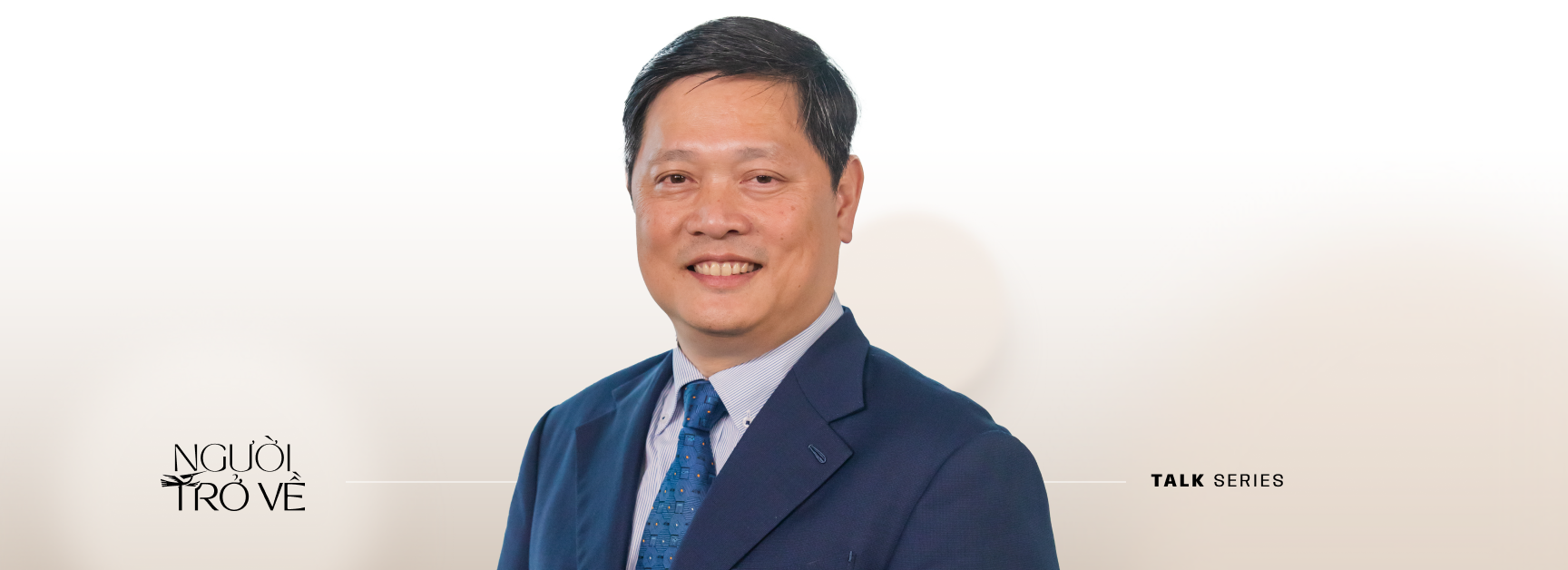 |
Content: Thuy Ngan - Diem Hanh
Video: Lam Nguyen - Trung Kien - Ky Anh
Photo: Thanh Nguyen
Graphics: Hoang Khanh



